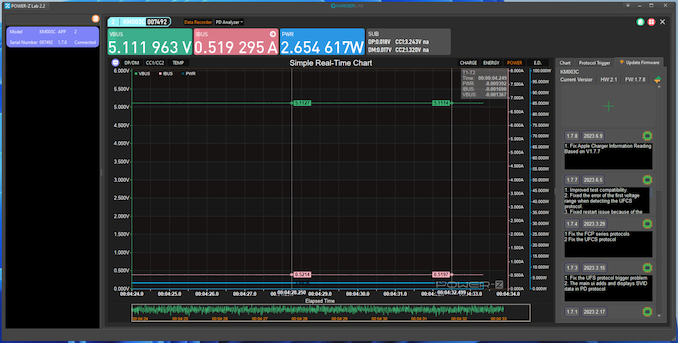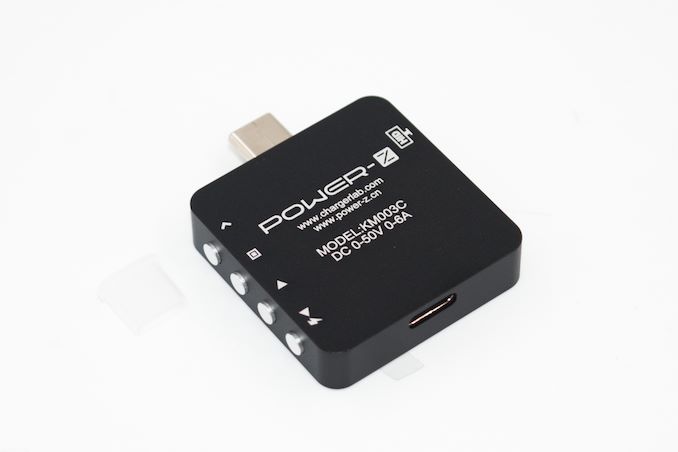USB-C Power Metering with the ChargerLAB KM003C: A Google Twinkie Alternative?
by Ganesh T S on July 5, 2023 8:00 AM EST- Posted in
- Gadgets
- USB PD
- Power Assessment Tool
- USB-C
Concluding Remarks
Our evaluation of the ChargerLAB KM003C for the purpose of USB-C power metering returned very good results, making it a credible alternative to the Plugable USBC-TKEY / Google Twinkie for our use-case. The hardware build quality is top notch, with the aluminum enclosure miles ahead of the flaky transparent polycarbonate shell enclosing the Twinkie PCB in the USBC-TKEY. The KM003C also comes with an aluminum box to store the device safely when it is not in use.
Most mainstream consumers opting to purchase the KM003C do it to ensure that their USB-C chargers are operating as expected and delivering the appropriate amount of power to the sink. Despite the emergence of USB-PD, many custom fast-charging protocols with varying voltage and current levels are also present in the market. The KM003C has the ability to recognize a large number of these custom protocols and give feedback to the user on the power at which a device is getting charged.
A search on Amazon reveals a large number of USB power meters, and a few of them like Plugable's simple-to-use USBC-VAMETER3 are from reputed brands. However, most of the low-cost ones (including the Plugable model) just present the collected data on a screen built into the device. Only a few models allow for monitoring and processing the collected data externally, and very few actually provide APIs for this purpose. ChargerLAB's KM003C belongs to that rare category, and provides API details as well as a demo program using those APIs. Additionally, very few allow high-speed data pass-through, and the KM003C and the Plugable USBC-TKEY / Google Twinkie are the rare exceptions that can support pass-through up to 40 Gbps.
One of the unique aspects of the KM003C is that its manufacturer (ChargerLAB) has been releasing frequent firmware updates to address bugs and add new features. They also maintain a technical blog detailing the features of the product. The posts serve as an introduction to some of the advanced features of the KM003C. On this front, ChargerLAB seems to be comprised of hardware enthusiasts who understand the needs of power users. ChargerLAB's support team is also quite responsive. I had mailed them once prior to purchase (wanting to check whether the KM003C could be used as an alternative to the Google Twinkie / Plugable USBC-TKEY), and they helpfully pointed me to their transmission test blog post and the FAQ section in their technical support page. I also communicated with them about the sampling rate issue, but after a few days they could not come back to me with an appropriate answer (that I was looking up the wrong bits from the returned data structure). That said, the e-mail exchange was definitely on a much higher technical level than any of my previous tech support conversations with other vendors.
The KM003C is also relatively future-proof, and claims support for 240W PD measurement when adapters supporting that wattage are not even available in retail yet. The digital power monitoring chip is one of the primary components restricting the usage of certain USB power meters with higher wattage power supplies. Even though the USB-PD 3.1 protocol only goes up to 48V, the INA228 metering chip can withstand up to 85V (the KM003C is rated for 0-50V).
In terms of scope for improvement, the KM003C does have an outstanding issue with passing USB 2.0 traffic. While the product does come with an online English manual, the API description document is only in Chinese. A more detailed multi-lingual version would be nice to have. Allowing replication of functionality such as altering the settings and tracking charge / energy via APIs should also be included. The software accompanying the device has many features, but is not particularly stable (with the application terminating unexpectedly under some circumstances).
A replica of the on-device screen in the software would be nice to have for easier remote operation. A 'Virtual Display' tab in addition to the 'Data Recorder' and 'PD Analyzer' that replicates the on-screen contents along with virtual buttons to allow cycling through different options (just like physically operating the buttons on the device would) would make the user experience better. Often times, it is difficult to keep track of the behavior of each button in different screens. Being able to handle this from the software would make things much easier.
The features of the KM003C make it appeal to a wide variety of consumers. However, for specific use-cases like ours, features such as the on-device screen and physical buttons are not particularly useful. Allowing everything to be accessed and controlled via the HID port and removing the screen / buttons to reduce the BOM cost (and end-use pricing) in a KM003C-Lite would be a consumer-friendly move from ChargerLAB.
Overall, the ChargerLAB KM003C springs a pleasant surprise by providing capabilities that go above and beyond the claims in their marketing material. The core capabilities have been reviewed with good results by multiple outlets on YouTube. Since they are incidental to our primary use-case, we did not bother with testing those in detail. Our aim was to evaluate whether the KM003C would make a good relatively future-proof alternative to the Google Twinkie for power metering, and we are glad to report that the product passed the test with flying colors. There is some scope for improvement as outlined earlier in this section, and the product could do with some competition to drive down the pricing. The KM003C is available in China for around 400 RMB, which translates to around $55. On Amazon, the product is available for double the price - $110. Even accounting for import costs, the markup is a little hard to digest. Despite this premium pricing, we believe that the KM003C should be part of every USB-C power user / developer's toolkit.












20 Comments
View All Comments
ballsystemlord - Wednesday, July 5, 2023 - link
It's unfortunate that the KM003C is windowz only closed source.ganeshts - Wednesday, July 5, 2023 - link
It is not a major problem, as I have demonstrated in a couple of sections. You can use libusb or any other serial port access program to communicate with the KM003C and create a wrapper suited for your particular use-case.That said, one aspect I should have mentioned in the conclusions is related to the ability to update the firmware independent of the closed-source Windows program. Coupled with better API documentation, that would basically make the device pretty functional without having to rely on the closed-source program.
ballsystemlord - Wednesday, July 5, 2023 - link
Oh, I see.QChronoD - Wednesday, July 12, 2023 - link
Since you posted a screenshot of the code for connecting and pulling out the relevant power data, are you OK with people using it? Are you planning on posting it on github or somewhere?ganeshts - Thursday, July 13, 2023 - link
Absolutely! Code is free for anyone to start off with as the base point for their own programs.My github account has been idle for a few years now. I will probably upload a refined version of the code that appears in this review later this year when I get time. The only reason I didn't post the code as text is to avoid making the review appear like a StackOverflow post :)
TrevorH - Thursday, July 6, 2023 - link
You could have saved me from going straight to the last page by putting the price at the top of the article. At $10 I would have snapped your hand off, at $110 it's a definite no.ganeshts - Thursday, July 6, 2023 - link
I think it would be impossible to hit $10 for this type of product. Even BOM cost for microcontroller + 5 ADCs would easily exceed that (even if they are bought in 1Ku quantities). Need to add software development and distribution costs. I would imagine break-even is itself around $40 - $50.ads295 - Saturday, July 8, 2023 - link
+1It's not for "hobbyists" as mentioned in the article.
Bp_968 - Thursday, August 3, 2023 - link
Not sure I agree that 50$ puts it out of reach of "hobbyists". I'm a hobbyist and own a oscilloscope, and a number of other test tools more expensive then 50-100$. If all your doing is seeing what voltage your usb battery is negotiating with your switch or steamdeck then yes, this device is overkill. But if you building anything that's using PD or other usb-c features this could be extremely useful.I'm unlikely to build anything anytime soon that would require the features this thing supports but I still want one! ;)
DanNeely - Thursday, July 6, 2023 - link
"The KM003C can support up to 50V / 6A (full USB-PD 3.1 specifications, with EPR up to 240W)."Unless this device is going significantly beyond USB-PD levels I believe this should read 5A not 6.